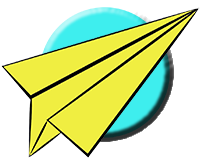Folding Instructions for the Trout Paper Airplane
Folding Instructions for the Trout Paper Airplane
Instructions
1. Fold the paper exactly in half about its short edge. Unfold after the crease has been made.
2. Fold the paper exactly in half about its long edge. Unfold after the crease has been made.
3. Bring the point at the right edge of the short horizontal crease down so it hits the long vertical crease. The right half of the short horizontal crease should line up exactly with the center line crease and the new crease should go through the center point.
4. Rotate the paper around so the new crease is on the right. Fold the paper exactly in half bringing the top point down to meet the bottom point. Unfold after the crease has been made.
5. Rotate the paper around so the folded edge is at the top.
6. Make a crease to fold the top right point down so it hits the bottom right diagonal edge. The left point of the new crease should be on the top edge where the center line crease ends.
7. Unfold after the crease has been made.
8. Make a crease to fold the right diagonal edge over. The right diagonal edge should line up exactly with the diagonal crease created by the previous fold.
9. Fold the right diagonal edge over on top of itself.
10. Fold the right diagonal edge over on top of itself again.
11. Position the paper to repeat the previous series of folds on the left side. Make a crease to fold the top left point down so it hits the bottom left diagonal edge. The right point of the new crease should be on the top edge where the center line crease ends.
12. Unfold after the crease has been made.
13. Make a crease to fold the left diagonal edge over. The left diagonal edge should line up exactly with the diagonal crease created by the previous fold.
14. Fold the left diagonal edge over on top of itself.
15. Fold the left diagonal edge over on top of itself again.
16. Fold the tip of the nose down so the top point hits the center line crease. Make the crease about three finger widths from the top point.
17. Flip the plane over and rotate it around so the nose points to the left.
18. Fold the plane exactly in half about the existing center line crease. Be sure to line up the wing flaps for good balance.
19. Rotate the plane around so the nose points to the right.
20. Make a crease for the first wing flap. The left point of the crease should be at the lower left corner of the fuselage and the right point should be about one finger width up from the bottom edge of the fuselage.
21. Make a crease for the tip flap. The left point of the new crease should be where the two layers of paper overlap along the back edge and the right point should be at the right edge where the center line crease ends.
22. Flip the plane over and rotate it around so the first wing flap is underneath and the nose points to the left.
23. Make a crease for the second wing flap. Be sure to line up the wing flaps for good balance and flying characteristics.
24. Make a crease for the second wing tip flap. Be sure to line up the wing tip flaps so they are even.
25. Open up the wing and wing tip flaps and adjust them so they are even. Be sure to balance the plane from left to right for the best flight results. Set the dihedral angle somewhat down with the outer wing flaps upward at a corresponding angle.
THE THROW Launch with a moderate to hard level throw or at a slight down angle. Some up elevator may have to be added to the tail flaps. This craft is sensitive to uneven folding, the dihedral angles, and the settings of the elevators. It can be trimmed for glides or for fast acrobatic flights.
